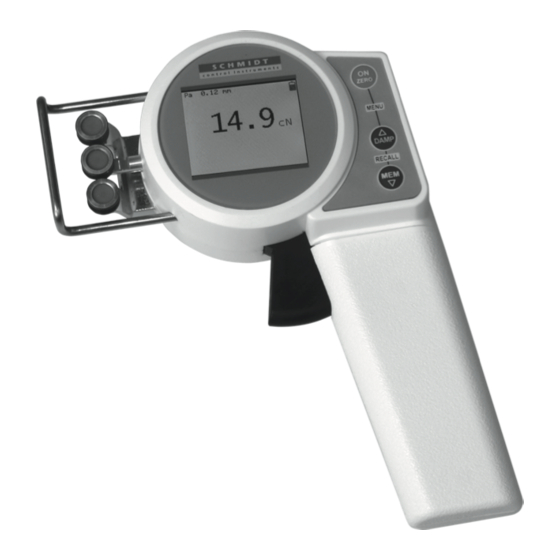
Summarization of Contents
Warranty and liability
Notices within the operating instructions
Key safety notices and instructions for safe operation are crucial.
Responsibilities of the operating company
Outlines the company's duties for safe device operation and personnel training.
Responsibilities of the personnel
Defines personnel duties regarding safety regulations and instruction understanding.
Safety and Handling
Informal safety measures
Operating instructions must be kept handy; comply with local regulations.
Training of the personnel
Only trained personnel may operate; trainees require supervision.
Intended use
Device is exclusively for tension measurement; other uses are misuse.
Dangers in handling the device
Potential for injury or damage; use only faultless condition and PPE.
Copyright
Copyright of operating instructions remains with the company.
Declaration of conformity and registration
Compliance with EU directives and German electrical equipment act.
Available Models
Specifications
Details technical specifications of the tension meter models.
Model Details and Handling
ZEF and ZED Guide Rollers
Details types and materials of guide rollers for ZEF and ZED models.
Connecting the tension meter
Requirements for CE compliance when connecting the tension meter.
Delivery includes
Lists the items included in the tension meter package.
Unpacking
Instructions for unpacking and inspecting the tension meter for damage.
Operations - Getting Started
Notes before starting measurement
Crucial safety reminder to read and understand operating instructions before use.
Operating and display elements
Identifies and explains the function of all control keys and display indicators.
Display Modes
Numeric and Bargraph Displays
Explains the different display modes and their information content.
Graphic Display
Describes the graphic display mode and how to switch between displays.
Setup and Battery Management
Setup procedure
Details the initial setup process for the tension meter.
Battery charging and care
Guidelines for charging, battery life, and storage of the LiPo battery.
Tension Meter Settings and Operation
Charging the Battery
Instructions for charging the device's battery safely and correctly.
Switching the tension meter on/off
Procedures for powering the device on and off, including auto-off.
Accessing the main menu
How to navigate and use the main menu for settings.
Tension Meter Settings Menu
Material Setup Menu
Configure material characteristics for measurement and calibration.
Display Settings
Adjust display mode, time scale, background, and screen rotation.
Alarm and Damping Settings
Configure alarm limits and damping factor.
General Settings
Set units, backlight, auto power off, and language.
Material Setup and Factory Reset
Material setup menu details
Define name, limits, and calibration points for material characteristics.
Factory reset procedure
Restores the tension meter to its original manufacturer settings.
Operation Procedure
Requirements for operation
Prerequisites for starting a measurement procedure.
Zero adjustment of measurement position
How to perform manual zero adjustment if needed.
Inserting and Removing Material
Inserting process material
Step-by-step guide for placing material into the device.
Removing process material
Procedures for safely removing material after measurement.
Damping and Alarm Function
Damping feature explanation
How to use damping for fluctuating tension values.
Using the alarm function
How to set and use min/max alarms for measurements.
Creating Material Characteristics
Setup for calibration
How to set up the device for calibration with weights.
Calibration Procedure
Calibration units and points
Details on units (cN/g) and calibration points (10/50/90%).
Performing the calibration
Steps to select material and perform calibration.
Step-by-Step Calibration
Step 1: Set calibration points
Setting calibration points and weights for measurement.
Step 2: Perform zero adjustment
Performing zero adjustment before calibration.
Steps 3-5: Calibrate points
Calibrating the three defined points of the measurement range.
Verifying Calibration
Verification procedure
Steps to verify calibration accuracy using suspended weights.
Handling during verification
Precautions to ensure accuracy and prevent instrument damage during verification.
Memory Functions
Saving measured data
How to save and overwrite measured values.
Displaying saved data
Viewing statistical values and graphs of stored measurements.
Deleting saved data
Procedure to delete all stored measurement data.
Service and Maintenance
Rollers Information
Details on spare rollers, model numbers, and delivery.
Cleaning Instructions
Guidelines for cleaning the device and solvent warnings.
Verification Interval Recommendation
Recommendation for calibration verification frequency.
Verification of Calibration and Repair Costs
Flow chart for verification and repair
Visual guide for the process of calibration verification and repair cost determination.
Correspondence and Repairs
Correspondence Information
Details needed when contacting for support or questions.
Shipping and Repair Instructions
How to ship the instrument for repair and required documentation.
















Need help?
Do you have a question about the ZEF-50 and is the answer not in the manual?
Questions and answers